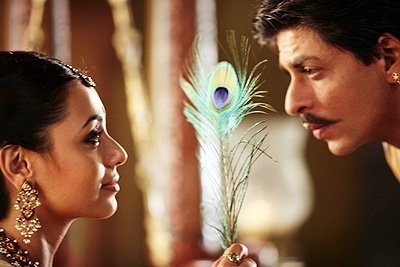
 |
 Red Chillies Entertainment, SRK’s production company, returns to the big screen after 2004’s Main Hoon Na with 2005’sPaheli. Boasting of a stellar starcast with such names asAmitabh Bachchan, ShahrukhKhan himself, Rani Mukherji, JuhiChawla, and Suniel Shetty, the film also marks the first true commercial venture of renowned filmmaker Amol Palekar. Based on a Rajasthani novel entitled “Duvidha” by author Vijaydan Detha, the film tells the story of a married village girl who falls in love with a ghost who takes on the appearance of her husband. Red Chillies Entertainment, SRK’s production company, returns to the big screen after 2004’s Main Hoon Na with 2005’sPaheli. Boasting of a stellar starcast with such names asAmitabh Bachchan, ShahrukhKhan himself, Rani Mukherji, JuhiChawla, and Suniel Shetty, the film also marks the first true commercial venture of renowned filmmaker Amol Palekar. Based on a Rajasthani novel entitled “Duvidha” by author Vijaydan Detha, the film tells the story of a married village girl who falls in love with a ghost who takes on the appearance of her husband.
The album’s music is created by M.M. Kreem, a music director whose music is featured in only a few albums a year. Kreem is the director who earlier crafted wonderful compositions in films likeZakhm, Sur,Jism, Saaya, and even Criminal (who can forget “Tu Mile Dil Khile”?) In this film, Kreem is responsible for turning Gulzar’s poetry into song. Sonu Nigam and Shreya Ghoshal unite for the first track, “Dheere Jalna”. The song begins with just Nigam’s voice, which is at its best. The tempo is slow and gradually music is added tocompliment his vocals. The song treads the territory of classical music and M.M. Kreem does full justice to the song. Flutes,tablas, shehnaais - they are all featured in this song. The song alternates between slow, soft, and mellow to fast and loud; however, it’s done in such a way that the change in pace flows well. Ghoshal joins Nigam towards the end and proves again why she is a force to reckon with as far as female vocalists are concerned. The song is easily the best on the album. Classical music continues to predominate in the next song, “Kangana Re”, a song that contains strong elements of Rajasthani folk music. The song is sung by Shreya Ghoshal who is joined by Bela Shende, Madhushree, and Kalapini Komakali, who is responsible for the husky, deep Rajasthani vocals interspersed throughout the song. Gulzar displays his immense versatility by fine-tuning the lyrics to adapt perfectly to Rajasthani culture. Ghoshal is the lead-player in this song and does a wonderful job. Sonu Nigam is briefly featured in this song as the only male voice and does a more than adequate job.
Kreem plays a different role with “Laaga Re Jal Laaga”, this time as a singer featured in his own composition. He is joined by Sonu Nigam and Shruti Sadolikar for this purely situational song whose theme focuses on a rainfall. Nigam continues to excel and is the main vocalist in this song, with support from Kreem mainly during the chorus. Sadolikar makes an appearance towards the end of the song with her heavy, husky vocals most likely suited for a mother figure in the film and not for our main heroine. One of today’s most underrated male vocalists, Hariharan, joins BelaShende for “Khaali Hai Tere Bina Dono Ankhiyan”. The track begins with an interesting violin instrumental and is gradually joined by Hariharan’s voice, which perfectly reflects the pathos our hero is experiencing at this particular moment in this film. Hariharan renders such a poignant performance that it sounds as though he is the one suffering.Shinde’s voice is pleasant and ironically similar to Ghoshal’s and although she does a fine job, one can’t help but to miss Ghoshal on this slow-paced, emotion-laden track. The final track is “Minnat Kare”, another situational song that features only female singers. Sung by Madhushree, Shreya Ghoshal, and BelaShende, the song’s strongest aspect is its lyrics which convey a group of girls’ instructions to her friend on how to playfully refuse her lover. The song should appeal to many, especially those who appreciate Gulzar’s lyrical abilities.
|
| Comments | Contact Us | Advertise | Terms of Service | Privacy Policy |